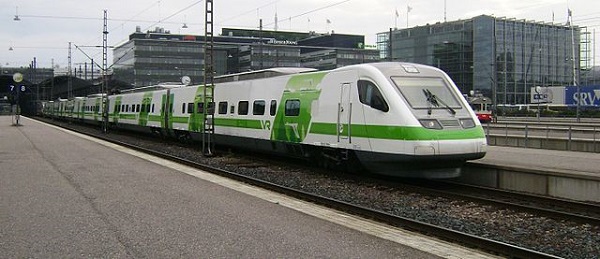
Rail strikes stopped travel in the Finnish capital area on 18-19 March and again on 9 April, as conductors stopped work in separate protests over potential job cuts and imposition of worse working conditions.
Tero Palomäki, the spokesperson for Finnish railway union RAU, confirmed to socialistworld.net that conductors launched the strikes “spontaneously,” without any official organizing by railway union leaders.
The strikes took place on two different parts of the Helsinki commuter train system and on the national rail system, and both targeted the state-owned rail employer, VR (his stood for Valtionrautatiet, “state railways”, but the official name of the company is now just VR). It is preparing itself for a sell-off to the private sector and has plans to indefinitely furlough up to 4,000 of its 7,500 employees. As with the state-owned postal service company, Posti, the rail company has also used the COVID crisis as an excuse to attack its workers.
The March strike was in response to what has become a common occurrence in Finland: employers reclassifying their employees and imposing a worse recognition agreement on them as a way to circumvent legal employment protections. Workers sat through eight months of stalled negotiations and saw the strike as the only way to make some progress. “It is very difficult for employees today to make their voices heard,” wrote Palomäki. “The strike gives them visibility.”
State news agency, YLE, meanwhile, attributed the April strike simply to threatened job cuts, but Palomäki went on to explain it was the stalled negotiations. One conductor who organized the 9 April strike told us: “Drivers are very disappointed with the actions of the employer. The idea of a strike was a spontaneous reaction.” Workers won the immediate demand of their strikes — the bosses have returned to the negotiating table. But whether the conductors have gained an advantage in the negotiations remains to be seen, and peril lies ahead.
It is common practice in Finland, as in much of northern Europe, for unions and bosses to collaborate on agreements to cut jobs and worsen conditions. Under these circumstances, it is no surprise when workers begin organizing on their own, independent of bureaucratic leaders of the main unions. Similar strikes were organized by Finnish postal workers in 2019 and Swedish dockworkers in 2018, forcing established union leaders to pay attention.
Union potential
These heroic strikes face severe limitations without the organizational potential of the whole union behind them. Workers need to fight on many fronts at once – on the picket lines against their bosses, but also for control of their unions through the organization of activists’ caucuses and shop stewards’ networks.
And workers need to fight together as a class. The rail worker we corresponded with told us of the ongoing need for investment in infrastructure. “The railway system must be developed and maintained. The Finnish network is currently in considerable debt for repairs.”
The fight for a working-class political voice, for good public services and for preservation and improvement of working conditions, can only come together through the building of a mass socialist party of the working class. A continuous line links the openly right-wing government of technocrat Sipilä with the self-proclaimed “centre-left” of ex-union man Rinne and superstar Marin: they’ve all been pushing ahead with plans to shrink the public sector and sell off important public services to profiteers.
Finnish workers need a loud, clear socialist voice for all union members and all oppressed people. The CWI is building this voice on every continent. With capitalist rulers eager to add a new wave of austerity and selloffs to workers’ woes, the need for such a voice is more urgent every day.
Special financial appeal to all readers of socialistworld.net |
Support building alternative socialist media Socialistworld.net provides a unique analysis and perspective of world events. Socialistworld.net also plays a crucial role in building the struggle for socialism across all continents. Capitalism has failed! Assist us to build the fight-back and prepare for the stormy period of class struggles ahead. Please make a donation to help us reach more readers and to widen our socialist campaigning work across the world. |
Donate via Paypal |
| M | T | W | T | F | S | S |
|---|---|---|---|---|---|---|
| 1 | 2 | 3 | 4 | |||
| 5 | 6 | 7 | 8 | 9 | 10 | 11 |
| 12 | 13 | 14 | 15 | 16 | 17 | 18 |
| 19 | 20 | 21 | 22 | 23 | 24 | 25 |
| 26 | 27 | 28 | 29 | 30 | ||

